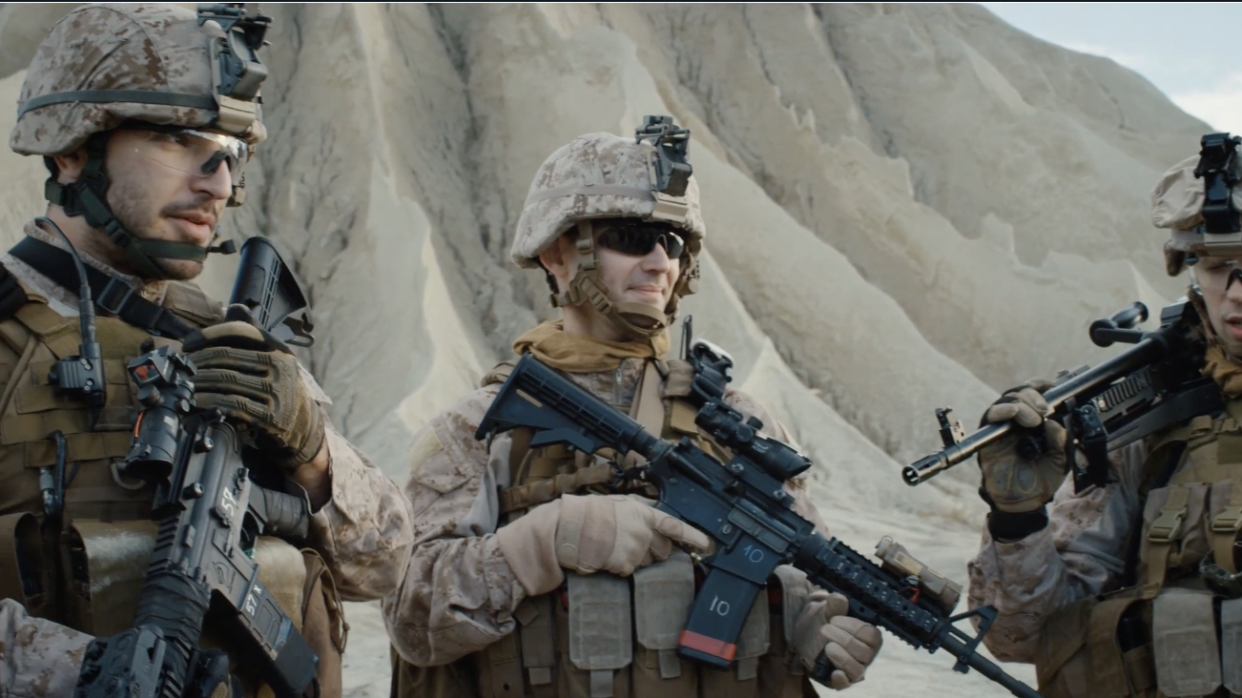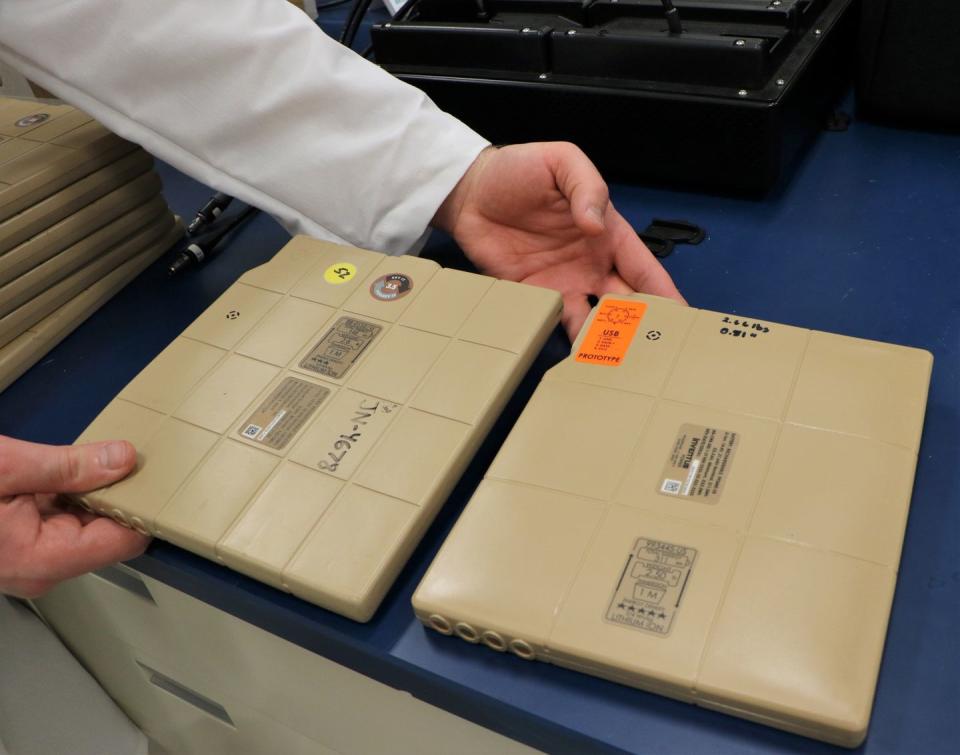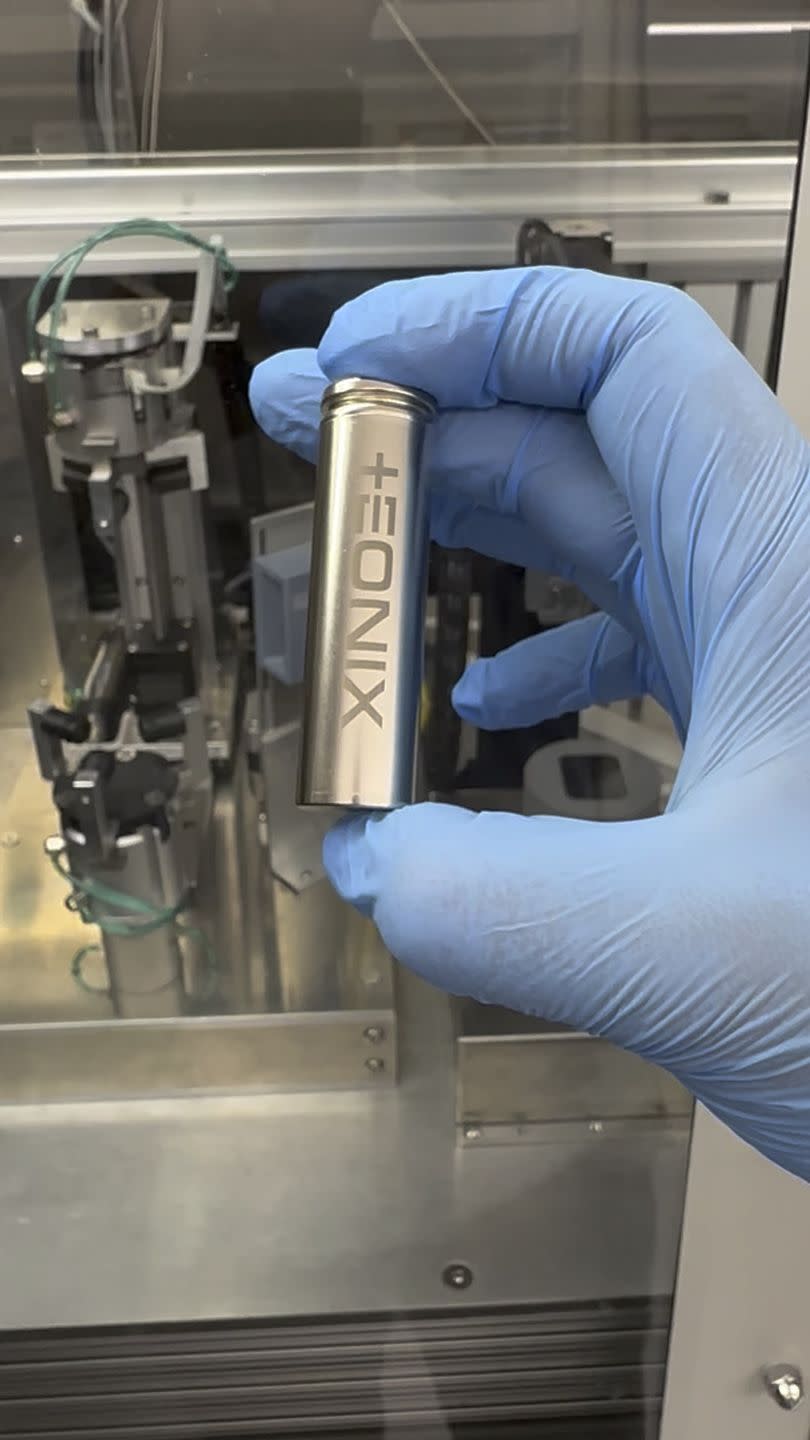The New Battery That May Help Soldiers Finally Harness Maximum Energy

Battery management is increasingly common in video games like Deus Ex, Tears of the Kingdom, and Crysis. Gadgets allow you to turn invisible or power an airplane—but only until your batteries run dry.
But battery capacity isn’t just a game mechanic for sci-fi super-soldiers. Advanced sensors, communication systems, jammers, navigation systems, small drones, medical devices, directed energy weapons, and propulsion systems all increase electrical demands on soldiers in the field. And fighting in Ukraine has revealed that even small, frontline infantry squads and platoons in the trenches need their own drones and drone-jammers to have acceptable survival odds.
While the latest military vehicles incorporate auxiliary power units (APUs) to help keep their systems running even with engines off, troops on foot are stuck lugging lots of heavy batteries. That’s a problem, as soldiers already average at least 60 pounds of gear each—and sometimes dozens of pounds more.
Army research into more convenient portable batteries began in the early 2010s. Finally, in 2021, the Army handed out contracts to Inventus Power, Bren-Tronics, Navitas Systems, and Ultralife Corps to compete for a contract worth up to $1.25 billion. The objective: a 2.5-pound Conformal Wearable Battery (CWB) that could be easily integrated into the front, side, or back pockets of body armor with ballistic plates inserted, distributing battery weight with minimal discomfort for soldiers.
The challenge was clear—not only did this battery need to achieve extraordinary energy density, but it needed to be ‘bendy’ to conform with body armor and had to pose no safety hazards to soldiers using them in the least-safe places imaginable. The requirement documents specify testing the effects of penetration by 7.62-millimeter bullets, immersion in salt water, and exposure to salty fog and explosive decompression, amongst other situations.

The CWBs are particularly aimed at powering Nett Warrior, a combo of smart phone (most recently, the Samsung S20) and PRC-154/A secured radio used by dismounted infantry and cavalry leaders. The phone uses Android Tactical Assault Kit software to graphically display the position of friendly and adversary forces on a geo-referenced map, and communicates with other leaders by transmitting/receiving texts, audio, GPS coordinates, and video streams. Testing of the conformal batteries used for Nett Warrior in the mid-2010s found that they extended usability by 20 hours and required 4.5 hours to charge.
While 150 watt-hour CWBs are presently being fielded, considerably more capable solutions are in the works. Inventus’s offering uses a promising alternative battery cell type known as silicon anodes, which in principle offers ten times the energy density of carbon-based graphite anodes used in most lithium-ion batteries (LIBs).
According to Don DeRosa, CEO of battery materials research company Eonix, energy-dense silicon is basically required by the Army’s “ambitious” requirements for a 300 watt-hour CWB. “Silicon is the most near-term commercial solution that can be prototyped today,” he told Popular Mechanics. “It isn’t a question of whether [the CWB] uses a silicon anode, but how much silicon is needed for a silicon anode.”
The reason silicon anodes aren’t already widely used is that they’re infamous for expanding up to 300% on contact with lithium, which can lead to material cracking. That’s a big problem.
Amprius Technologies is one of the suppliers of silicon anode batteries that have overcome what seemed to be an insurmountable physical principle. According to Amprius’ CTO Dr. Ionel Stefan, the secret sauce is a proprietary silicon anode that’s designed to accommodate the expansion experienced during charge and discharge of the battery, preventing contact between silicon nanowires.
“That was the innovation: in addition, we developed an electrode that makes the cell much safer,” Stefan told Popular Mechanics. “Inside the cell, you have a number of anode and cathode layers. The anode isn’t a dense crystalline silicon. It’s more porous, amorphous and fluffy, like snow compared to ice. The second part is they don’t touch due to the distance between each layer—even if there’s some material expansion in each wire. [Other batteries using silicon] rely on spherical particles contacting each other. So when they expand, they push into each other and expand the cell causing damage. Ours don’t do that.”
“It’s very important to pair the silicon material, a high-energy density anode with a high energy density cathode to get the best at the cell level,” he continued. “High-energy density cathodes are now what we work for. The ratio between capacity of anode and cathode is now 10:1.”
Once architecture and transfer efficiency are accounted for, the capacity output is ‘just’ twice that of graphite LIBs. But doubling battery capacity is still a big win, as improvements to battery capacity efficiency globally lag very far behind the exponential advancements in computer processing power, data storage, and data transmission.
For a good measure, Amprius cells are rechargeable (which isn’t necessarily the case for all batteries used by the U.S. Army), and can recharge quickly—up to 80% in 60 minutes.

According to Stefan, tens of batteries, each with multiple silicon anode cells inside, have already been tested operationally. “Almost all military batteries look like bricks and are mounted in a backpack,” he said. “But this one looks more like a book. It’s pretty big and expected to be in the side pocket in the vest. So it has to be bendable.”
Amprius had already developed double-capacity 300 watt/hour battery cells in 2021, but hadn’t yet optimized their safety aspect. Finally, in December of 2022, a revised cell was subject to a test in which it was penetrated by a 2.7-millimeter diameter stainless steel nail while fully charged. It passed the test, meaning it didn’t emit smoke, catch fire, or rise beyond an internal temperature of 338 degrees Fahrenheit.
Competing on cost for the next-generation battery
But how much will these safer, bendable, double-capacity batteries cost?
Amprius’ rivals in the silicon anode market are competing on the basis of price. While Amprius is distinguished for using pure silicon, competitors use mixes or alternative approaches (silicon particles, silicon washes, etc...) that they claim deliver adequate performance more affordably.
Inventus, for example, is also receiving silicon-anode batteries from Enovix. These claimed to offer twice the energy density and be rendered safe by their BrakeFlow technology, which is aimed at actively heading off thermal runaway from internal shorts by carefully segregating electrodes in a way that resemble the layers of wafer cookies. The lack of adjacency should turn a potentially catastrophic thermal chain reaction into a slower, controlled discharge.
According to Stefan, the price for Amprius’ pure-silicon anode battery cells ultimately depends on manufacturing scale.
“Scale matters a lot,” he said. “On a small scale, there’s less automation, and that means much more labor which is relatively expensive here. As we scaled up, we saw significant cost reduction. So. for example, the scale up from our prototype to initial low-rate production resulted in a cost reduction of 90% by automating production. There’s a next level of automation we want to do in Fremont and in Colorado that will reduce it almost two orders of magnitude further.”
Ultimately, Stefan claims that at maximal production efficiency, Amprius’ batteries will arrive at price parity or lower than standard graphite batteries. The company has a gigawatt-scale factory under construction in Brighton, Colorado that it hopes will increase output and lower prices for their silicon batteries.
DeRosa, however, claims that scaling electrode production has intrinsic challenges. “A lot use chemical vapor deposition,” he said. “You can have so many issues—humidity in the room, current collectors, tendency to become brittle, mixing the slurry and different evaporation rates. And when you’re scaling to larger batches, that can change consistency.”
(Amprius wrote to Popular Mechanics that the above issues don't apply to its production processes so much as to competitors who use chemical vapor deposition.)

His company—Knoxville, TN-based Eonix—discovered the hard way that its initial research focuses weren’t scalable in a commercially viable manner. This led the company to pivot towards developing a tool to rapidly discover and design new materials that can ‘drop-in’ existing batteries. Eonix’s present project focus is developing non-flammable graphite anode battery cells using custom-designed electrolytes for the Army’s Next Generation Combat Vehicle (NGCV), aimed at replacing the venerable Bradley fighting vehicle. The company’s liquid electrolytes raise the battery cell’s flashpoint from 17°C to 150°C, which DeRosa claims is achieved at just a 10-15% increase in price.
He argues that electrolytes are easily scalable. And while Eonix’s current project isn’t the same as the double-energy density CWB cells, DeRosa notes that the company’s liquid electrolyte is electrode agnostic, meaning its compatible with silicon anodes.
Silicon anode batteries and small drones
Beyond portable CWBs for personnel to use on foot, an obvious application for both military and civilian users is to run electrically powered drones with intrinsically limited endurance and range. As it turns out, that’s the role for which Amprius expects to sell most of its battery cells.
“For those platforms to remain in the air overnight they need very, very, light batteries [with high energy density],” Stefan said. “It should be possible to recharge UAVs in the field, depending on the drone. They output 250 WH in energy, that’s significant. We worked with Teledyne on NANO-UAS. Those definitely can be charged from that type of battery.”
In 2024, Amprius expects to deliver 500 watt-hour/kilogram SiMaxx battery cells to several of its existing clients—including Airbus, BAE and AeroVironment—for “high-altitude pseudo satellites” and other stratospheric platforms that most likely play persistent surveillance or reconnaissance roles.
AeroVironment is making particular use of Amprius batteries in the improved Block 20 model of its Switchblade-300 Kamikaze drones, which are used in combat in Afghanistan and Ukraine. These have increased their use time from 20 to 30 minutes, and have improved their range thanks to a longer-distance datalink.

In January, Amprius also unveiled a new 400 watt/hour high energy-density battery known as SiCore to help meet customer demand. This line has flexible form-factor (available in both cylindrical and pouch-like options) and an enhanced life cycle.
According to Stefan, the Amprius batteries have not yet been tested and optimized for resilience when exposed to seawater, as such optimization was required for Japan to field its first lithium-ion battery-powered submarines.
“There is maritime interest for submersibles,” he said. “Our cells have high energy density for both weight and volume. And for unmanned submersibles and similar applications, volume [i.e. size] is more important than weight. I think we exceed any other tech in both weight and volume density.”
At present prices, the emerging silicon anode battery industry caters primarily to military and other specialized customers. But if these batteries meet performance and safety expectations, and can achieve the desired economies of scale, they have potential to lead to a broader, long-awaited breakthrough in battery capacity. After that, they may make their way from drones and battlefield communications systems to consumer devices like the smart phones likely used read this article.
You Might Also Like

